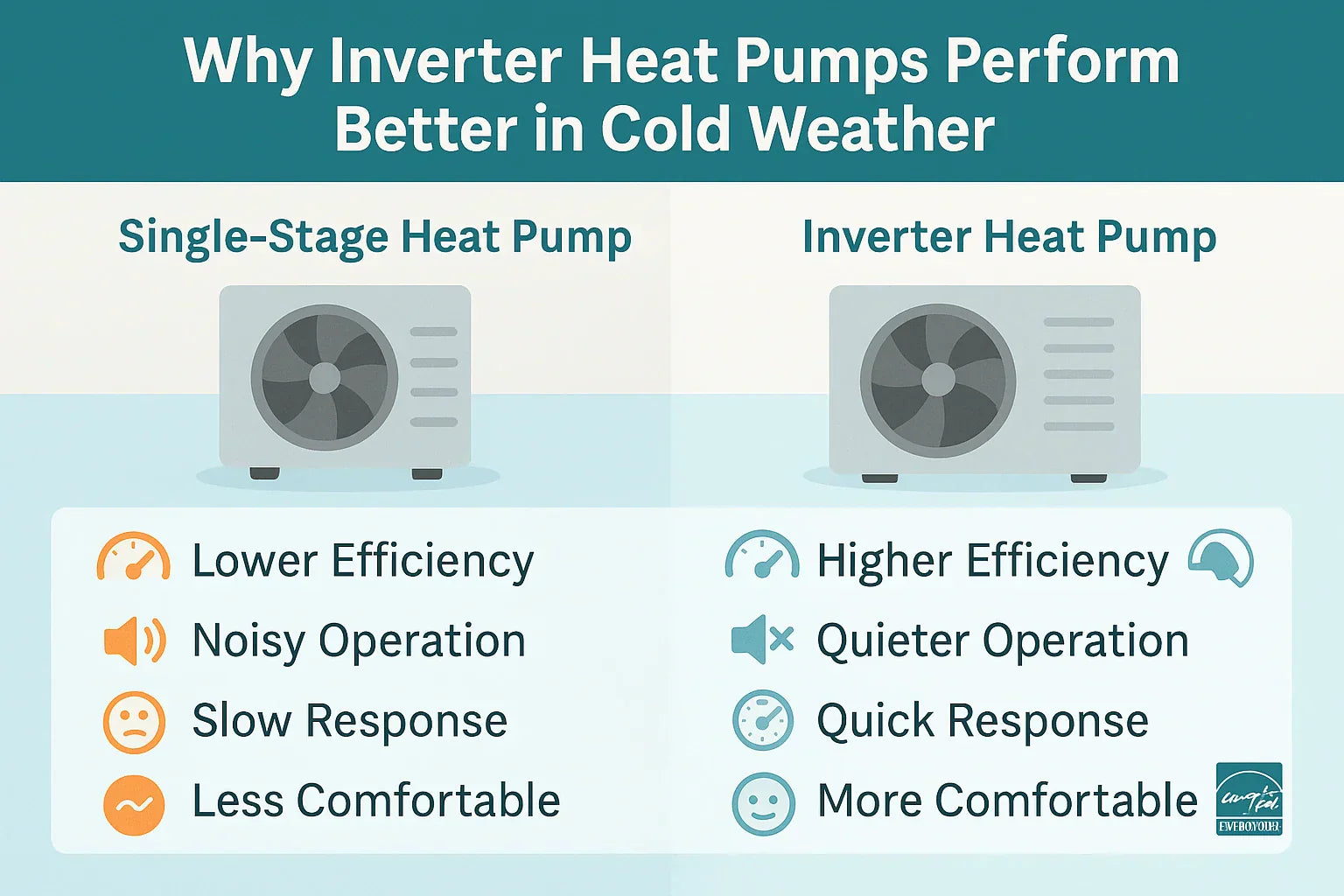Hi, I’m Alex Lane — your Home Comfort Advocate.
Over the years, I’ve helped countless homeowners upgrade to more energy-efficient homes. But here’s something many folks don’t realize: when you improve your home’s insulation and air sealing, it’s not just your utility bill that changes — your HVAC system needs to keep up too.
In cold climates especially, one of the smartest ways to match your system to your home’s needs is by choosing a heat pump with inverter technology. It’s not just a high-tech buzzword — it’s the feature that allows your system to adapt in real-time, delivering the right amount of heat exactly when you need it. Whether you're facing a mild winter morning or an arctic cold snap, inverter-driven heat pumps adjust to keep your home comfortable and your energy use in check.
Let’s dive into how inverter technology works, and why it’s a game-changer if you’re heating a home in a cold climate.
What Is Inverter Technology?
Inverter technology refers to a variable-speed compressor—the heart of your heat pump system. Unlike older single-stage models that blast at full power or shut off entirely, inverter-driven heat pumps modulate how hard they work based on real-time demand.
Think of it like cruise control in your car: instead of accelerating hard, stopping, and starting again, your system can coast smoothly and adjust with precision. That keeps your indoor temperature more stable and reduces the energy needed to maintain comfort.
📘 Energy.gov explains that variable-speed systems are significantly more efficient than traditional fixed-speed options, especially in areas with temperature swings.
Why Inverter Compressors Shine in Cold Weather
Steady Heat When Temperatures Plummet
Inverter technology allows your system to run continuously at lower speeds, avoiding the sudden stop-start cycles of standard units. That’s critical when the temperature drops below freezing and staying warm isn’t optional.
Conventional heat pumps often shut down or struggle in subzero conditions. But inverter systems, like those from Mitsubishi and Carrier, keep running efficiently—even when it’s well below 0°F.
📘 Mitsubishi Electric highlights how inverter heat pumps ramp up only when needed, helping you stay comfortable without spikes in energy use.
Faster Recovery Times
In cold climates, quick temperature drops are common. A sudden 20°F swing can overwhelm a single-stage system, but inverter units quickly adjust output, heating your home faster and keeping you comfortable with less strain.
Energy Efficiency = Real Savings
Lower Energy Bills
Because they avoid running at full blast all the time, inverter heat pumps consume less electricity overall. This smoother operation reduces utility bills throughout the winter.
Higher Efficiency Ratings
Look for units with high SEER2 (cooling efficiency) and HSPF2 (heating efficiency) scores. Inverter models routinely exceed 20 SEER2 and 9 HSPF2—excellent numbers for cold climate performance.
📘 Carrier explains that inverter-driven units operate at the most efficient speed for your current heating needs, helping avoid wasted energy.
Longer System Lifespan
Inverter technology reduces wear and tear on the compressor. The system isn’t cycling on and off constantly, which means fewer mechanical stresses and fewer breakdowns over time.
Real-World Benefits for Homeowners
-
No more temperature swings—inverter systems hold a steady temp even as conditions outside change
-
Quieter operation—no loud cycling on/off
-
Better humidity control—especially in shoulder seasons like early spring and late fall
-
Built for cold climates—many models maintain performance down to -13°F and below
📘 The National Renewable Energy Laboratory (NREL) found that inverter-driven cold climate heat pumps reduced heating costs and improved comfort across northern homes in real-world tests.
How to Choose the Right Inverter Heat Pump
Not every "high-efficiency" system includes full inverter performance. Some may offer dual-stage compression that simulates modulation but doesn't provide the same precision or cold-weather reliability.
What to Look For
-
“Variable-speed compressor” or “true inverter” in the product specs
-
ENERGY STAR “Most Efficient” designation
-
Models with published low-temp performance data at 5°F or lower
-
SEER2 and HSPF2 ratings of at least 18 and 9, respectively
📘 Use ENERGY STAR’s Most Efficient list to find certified inverter heat pumps built for cold climate performance.
Recommended Brands (2025)
-
Mitsubishi Hyper-Heating H2i®
-
Carrier Infinity® with Greenspeed® Intelligence
-
Lennox SL25XPV
-
Daikin Aurora™ Cold Climate Series
Bonus: Smarter Comfort with Thermostat Integration
Inverter heat pumps pair beautifully with smart thermostats that can adjust temperature based on occupancy, outdoor temps, and energy goals. You’ll get even more comfort control and potential savings.
Final Thoughts from Alex Lane
If you’re investing in a heat pump for a cold climate, inverter technology isn’t just a nice-to-have—it’s essential. It’s what allows your system to respond intelligently to changing conditions, maintain steady warmth, and save you money throughout the heating season.
So before you settle for a basic unit, take a closer look at what inverter-driven systems offer. It could mean the difference between fighting the cold—and mastering it.
👉 Want to learn more about top-rated systems built for snowy conditions? Start here: Best Heat Pumps for Cold Climates in 2025
👉 Curious whether heat pumps really hold up in freezing weather? Read next: Can Heat Pumps Really Work Below Freezing? Myths vs. Facts
Alex Lane
Your Home Comfort Advocate







